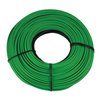Snow Melt Cable 208V, 21.64A, 376.5 ft.
How Much Cable Will I Need?
The amount of cable you'll need depends on the heat output and amount of heating coverage you want, both of which are impacted by the spacing of the heating cable.
The recommended spacing for snow melting cables is 3", which will provide a heat output of 48-watts per sq. ft.
You can use our quote tool to get a rough estimate of the amount of cable you'll need for a project.
Or contact us for help:
You can also submit a drawing of your project (with dimensions) and we'll provide you with a free installation plan with the exact amount of cable you'll need. Get started
Features
-
Automated snow and ice removal
-
Suitable for driveways and patios
-
Roof and gutter de-icing options
-
Energy-efficient and reliable
-
Easy installation for various surfaces
Snow Melt Cables Description
Protect your customers and your business with a commercial snow-melting cable. WarmlyYours’ 208V snow-melting cable installs in asphalt, concrete or mortar under pavers to safely and effectively melt snow and ice.
The 208V 377-foot-long twin-conductor heating cable is perfect for commercial applications, such as parking garage ramps, courtyards, sidewalks, stairways and more. It measures ¼” (6mm) in diameter, generates 12 watts per lineal foot (50 watts per square foot at 3” spacing) and includes 50 feet of cold lead to adapt to the needs of any installation.
All WarmlyYours snow-melting cables are CSA certified for outdoor use in U.S. and Canadian markets.
Learn more about snow melting systems. Perfect for heated driveways, patios, walkways and paths, accessibility ramps, or even stairs.
Specifications
Electrical
| Amps | 21.64 A |
| Ohms | 9.61 Ω |
| Voltage | 208 V |
| Watts | 4500 W |
| Watts Per Linear Ft. | 11.95 W |
| Watts Per Sq. Ft. at 3 Inch Spacing | Up to 50 |
| Watts Per Sq. Ft. at 4 Inch Spacing | Up to 38.5 |
| Watts Per Sq. Ft. at 5 Inch Spacing | Up to 31.5 |
Warranty / Certifications
| Approvals | cCSAus Listed |
| Warranty | 10 years |
Performance
| BTU Per Hour | 15355 Btu |
Product Dimensions
| Cold Lead Length | 50′ |
| Coverage at 3 Inch Spacing | 94.1 ft² |
| Coverage at 4 Inch Spacing | 125.5 ft² |
| Coverage at 5 Inch Spacing | 156.9 ft² |
| Heating Element Thickness | 1/4″ |
| Height | 0.25″ |
| Length | 376′ 6″ |
| Weight | 21.4 lbs |
| Width | 0.25″ |
Appearance
| Color | Green |
Identifiers
| SKU | WHCA-208-0377 |
| UPC (GTIN-12) | 881308047818 |
Installation
| Surface Types | Asphalt, concrete or in mortar under pavers |
Logistics
| UNSPSC Code | 40101842 |
Installation Plans
This is a real example of an installation plan that uses this product. If you want to design your own room or have any questions, please contact us.
Paver Subfloor
N/A Voltage
240V Operating Cost
150 cents per hour
This Installation Plan Includes:
Documents
Installation
- Snow Melting Installation Manual (English)
- Manual de Instalación para Sistemas de Derretimiento de Nieve (Spanish)
- Snow Melting & Slab Heating Application Cross Sections (Spanish)
- Snow Melting & Slab Heating Application Cross Sections (English)
- Snow Melting & Slab Heating Application Cross Sections (French)
- Snow Melting Installation Manual (French)
Project Planners
Technical Information
Warranties
Sell Sheets
Case Studies
Frequently Asked Questions
The material costs are similar. However, electric systems are easier to install, with fewer components and significantly lower maintenance costs. Electric systems will run for a shorter period of time to give the same level of performance but with much higher energy efficiency (typically 95%-98% efficient). Controls and sensors required for the two types of systems are very similar. Electric systems do not usually require slab insulation and do not create the concerns typically associated with hydronic systems. These concerns include, but are not limited to, return temperatures, flue gas venting, waterway shrinkage and property damage caused by leaking pipes or tubes.
When installing outdoor WarmlyYours snow melting cables for your driveway, patio, walkway, terrace, stairs, ramp, etc. - NEVER cross, overlap, or allow the heating cables to touch each other. Doing so will quickly cause a circuit failure due to excessive heat build up. Always follow the installation instructions and/or design layout plan to ensure the cable is installed with the correct spacing required for proper operation.
Our systems can handle low temperatures, but many controls come equipped with a Low-Temperature Lockout Feature. This feature prevents the system from running in very low temperatures. At very low temperatures it can become difficult for the system to effectively melt the snow. It is however possible to turn off this feature should you need the system to keep running during such low temperatures.











































